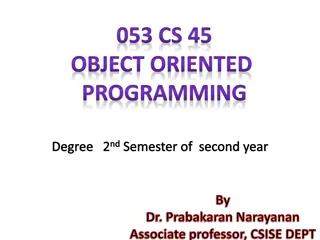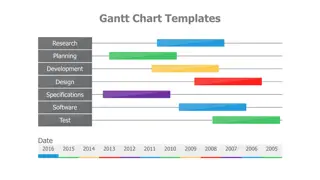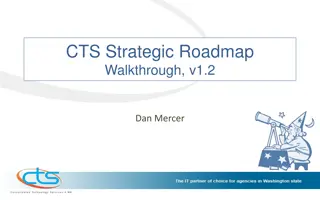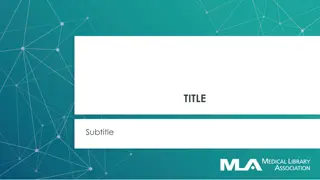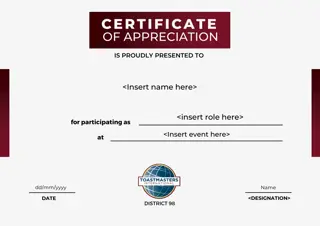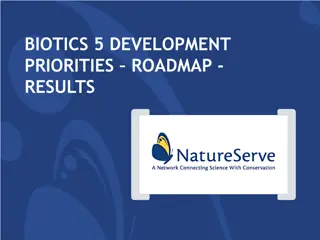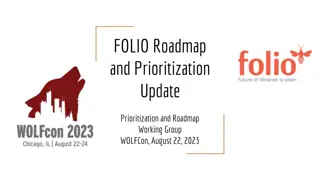
SEED Method for Stakeholder Engagement in Health Research
Explore the innovative SEED Method for developing stakeholder-driven health research. Learn about health research in the U.S., stakeholders, patient-centered research, and project details. Discover examples of health research topics and who funds health research. Understand how research topics are selected and the amount spent on health research in the U.S.
Download Presentation

Please find below an Image/Link to download the presentation.
The content on the website is provided AS IS for your information and personal use only. It may not be sold, licensed, or shared on other websites without obtaining consent from the author. If you encounter any issues during the download, it is possible that the publisher has removed the file from their server.
You are allowed to download the files provided on this website for personal or commercial use, subject to the condition that they are used lawfully. All files are the property of their respective owners.
The content on the website is provided AS IS for your information and personal use only. It may not be sold, licensed, or shared on other websites without obtaining consent from the author.
E N D
Presentation Transcript
Kickoff Meeting Template The SEED Method for Stakeholder Engagement in Question Development
What is the SEED Method? A new method to develop stakeholder-driven health research !
Todays goals Learn about health research in the U.S. Learn about stakeholders Learn about patient-centered research Learn about the SEED Method Review details of this project
Health research in the U.S. Basic medical research Epidemiological studies Prevention Disease detection, screening and diagnosis Disease treatment and intervention Health services and policy
Examples of health research topics Specific diseases Treatments and therapies Genetics and biological factors Environmental and social factors Health services delivery & financing Health policy Health disparities Maternal/child health Aging Mental health/behavioral health Health promotion/education Health information technology Occupational health
Who funds health research?1 Private industry Federal agencies Private philanthropy/foundations State and local institutions Health associations Universities/research institutes
How much is spent on health research in the U.S.? An estimated $130 billion was spent in the U.S. on medical and health research in 2012.1 3%1% 1% Industry 11% Federal Universities/institutes 53% 31% State/local Foundations Health associations
How do research topics get picked now? For publicly funded research, agencies solicit input from a range of stakeholders. Advisory board, councils, and committees Agency staff Research scientists and professional societies; Patient organizations and voluntary health associations; Institute and Center Advisory Councils; Political bodies (e.g., Congress); Many research proposals to NIH are investigator-initiated research in which the researcher submits the research question and a research plan.
Stakeholder input While there may be some areas for stakeholder input for research priorities, without systematic opportunities for engagement stakeholders like patients and health care workers are unlikely to have much say in what gets funded.
What is a stakeholder? Stakeholders have an interest in what happens in any project, initiative, policy, organization, etc. That is, what happens, how it happens, and the results matter to them. Who do you think has an interest in health research?
Patients and their caregivers What interests do patients have in health research? Causes of the disease Behaviors and their effects on disease Diagnosis Treatments Services Barriers to diagnosis, services, treatment Access to information and education Participation in decision making and advocacy
Community What interests does the community have in health research? Advocacy Informed decision making Providing information and education Understanding and addressing causes and risk factors Reducing risk Improving screening and detection Eliminating disparities
Health care providers What interests do health care providers have in health research? Understand causes of disease Understand risk factors and preventive measures Access to and dissemination of preventive measures Provide treatments and services Improve care delivery Improve patient outcomes Access to information and educational tools Improve technology Decision making and advocacy
Health care systems/funders What interests do health care systems and funders have in health research? Identify populations at risk Prevention Planning Improve treatments and services Improve care delivery Improve patient outcomes Information and education Improve technology Cost effectiveness and reducing total costs Financing and regulation
Policymakers What interests do policymakers have in health research? Understand extent of risk in population Assess needs and allocate resources Implement programs and policies to prevent spread and consequences of disease Support cost effective interventions Improve population outcomes Financing and regulation Ethics Respond to community/stakeholder concerns and values
Practice List 10 areas in which YOU are a stakeholder Hints: Are you a patient? Do you have kids in school? Do you own or rent a home?
Practice List 5 different approaches you can take as a stakeholder to represent or advance your interests.
Stakeholder involvement Level of engagement Type of engagement Examples Low Information Read newspaper; Attend informational meetings; Go to websites Consultation Go to a community forum and provide opinions; Participate in a survey or focus group Involvement Join an advisory board; Become an advocate Collaboration/partnership Work together to develop and implement a program High Control/decision making Budgetary/hiring control; Create/implement new policies
A New Model: Patient-Centered Research PCORI helps people make informed healthcare decisions, and improves healthcare delivery and outcomes, by producing and promoting high-integrity, evidence-based information that comes from research guided by patients, caregivers, and the broader healthcare community.
Improving Methods for Conducting Patient-Centered Outcomes Research2 Research that identifies optimal methods for engaging patients in the research process, and methods for evaluating the impact on research outcomes of patient engagement in the research process Research that determines methods for assuring study questions, outcomes, and interventions are meaningful to patients and other stakeholders Research in generating, selecting and prioritizing topics for research
What is Patient-Centered Outcomes Research (PCOR)?2 PCOR helps people and their caregivers communicate and make informed health care decisions, allowing their voices to be heard in assessing the value of health care options. This research: Assesses the benefits and harms of health care services and delivery features to inform decision making Focuses on outcomes that people notice and care about Addresses individual differences and barriers to implementation and dissemination May investigate optimizing outcomes while addressing stakeholder perspectives.
Question development and prioritization A priority problem When it comes to health and healthcare interventions, there are so many important questions! With limited research dollars we need to prioritize We need a set of methods to guide which questions the system should tackle first and a way to keep patients central in that prioritization process Too often this ranking has been done out of public view through a process subject to political and economic forces that lacks a coherent strategy.3 (page 7)
Stakeholder engagement in question development Including patients in topic generation is unconventional... patients should be engaged in all phases of patient centered outcomes research they may believe they know what patients want, their choices may be influenced by their training and by their professional or commercial interests. Without adequate input from patients, research priorities may not fully reflect patient perspectives on potential benefits or risks, ultimately impeding the uptake of research discoveries. Topic selection is usually done by researchers or sponsors, and while has shown that patient involvement can produce more relevant research questions and results that are more useful for making decisions. 3 (page 35). Some empirical research, mostly conducted outside the United States,
Phases of PCOR What should we study? What study designs should we use? How do we carry out and govern the study? How do we enable people to apply the study results?
Generating research questions3
Why test a new method? Particularly in methods to engage patients in prioritizing and refining research topics, it is not possible to identify evidence-based standards. We believe that standards for engaging patients in each phase of the research process are essential, but lack the evidence to specify which methods for doing so are best. 3 (page 21).
SEED Method: Background The SEED Method was developed in response to PCORI s Improving Methods program Participatory causal modeling as a starting point, then: Focused the process on question development and prioritization Created a number of new steps and participant types Developed instruments and procedures
SEED Method [Insert health condition/topic of focus]
SEED Method: Long-term Aims Provide a framework for future PCOR researchers to develop more robust causal models and to collaboratively generate research questions relevant to stakeholders
SEED METHOD: Who Participates? Three levels of stakeholder engagement 1. The Research Team Community-based participatory research (CBPR) team Collaboratively leads the research! 2. Topic groups Groups of stakeholders brought together based on their experience and knowledge of the health-related topic 3. SCAN participants Participate in focus groups and interviews
Three levels of engagement 1. Research Team: COLLABORATIVE 2. Topic Groups: PARTICIPATORY 3. SCAN Participants: CONSULTATIVE
Summary of SEED Method Process Facilitated meetings with stakeholder groups to create conceptual models Identify and recruit stakeholder participants Facilitated meetings with stakeholder groups to prioritize research questions Facilitated meetings with stakeholder groups to develop research questions Recruit participants and conduct focus groups and interviews Disseminate research agenda Identify and Engage Generate questions Prioritize Questions Disseminate Agenda Consult Conceptualize
Summary of SEED Method Process Research Team Members (examples): Patients/Community Members Service Providers University faculty/staff Community organizations Topic Group (examples): Patients/Caregivers Non-clinical service providers Clinical service providers Policymakers Community members Funders/payers SCAN Participant (examples): Patients/Caregivers Non-clinical service providers Clinical service providers Policymakers Community members Funders/payers Identify and Engage Finalize Research Topic Stakeholder matrix to identify TOPIC groups Recruit TOPIC group participants Consult Focus groups and Interviews Review data Conceptualize Review and edit conceptual models Training/Facilitated Exercise #1 Generate Questions Review questions Facilitated Exercise #2 Prioritize Questions Review and finalize questions Facilitated Exercise #3 Analyze findings and disseminate results Analyze results Present and publish results
Research Team Roles 1. Finalize Research Topic Identify the broad research area or topic Choose a topic that comes from the community or is generated in a collaborative process 2. Identify Topic groups (3-step process) Review health statistics and demography Conduct informational interviews with representatives of health care systems Complete Stakeholder Identification Matrices to develop a comprehensive plan for stakeholder engagement 3. Recruit Topic Group participants Establish inclusion criteria for recruitment, such as personal or professional experience with the topic, diversity, ability to commit to participation in research activities, etc. Recruit from local organizations identified in the Stakeholder Identification Matrix
Research Team Roles 4. Identify Topic groups (3-step process) Review health statistics and demography Conduct informational interviews with representatives of health care systems Complete Stakeholder Identification Matrices to develop a comprehensive plan for stakeholder engagement 5. Recruit Topic Group participants Establish inclusion criteria for recruitment, such as personal or professional experience with the topic, diversity, ability to commit to participation in research activities, etc. Recruit from local organizations identified in the Stakeholder Identification Matrix
Research Team Roles 6. Gather data from SCAN participants Plan focus groups and interviews Recruit participants Conduct focus groups and interviews Summarize data to share with Topic groups 7. Logistics and planning for Topic groups Schedule of activities: meeting dates, locations, logistics Group Exercises: Conceptual modeling, Question development, Question prioritization
Research Team Roles 8. Review and edit conceptual models Review causal models create by each Topic group, reconciling overlaps and highlighting differences 9. Review and finalize questions Refine the list of research questions utilizing a scoring process based on availability of current research evidence and relevance to PCOR 10. Present and disseminate results Finalize and implement the dissemination plan Conduct presentations to stakeholders
Topic Group Roles 1. Review SCAN Data Engage in group discussions of the issues that emerged, review and reflect on the themes, issues and concerns of others Reflect on their experiences in the context of others stakeholders experiences Did other people experience what I experienced? What else do others in this situation have to deal with? 2. Training in conceptual modeling
Topic Group Roles 3.Conceptualize (Activity #1) Each Topic Group will work as a team through a facilitated process to develop a conceptual model of the factors that influence the health outcome Part 1: Identification of factors: brainstorm, discuss and agree on list of factors related to the health outcome Part 2: Sketching the causal model
(Richmond, VA demonstration) Resources Job Money Attitudes/Beliefs Fear Motivation Hope Weather Health Behavior Exercise Avoid doctor Smoking Grow Food Macro Environment Violence Good Schools Temptation Social Family size Help with tasks Family support Diet Mental Health Being in your right mind Demographics Age Health Care service Treatments Eating Habits Appetite Mobility Physical Health Pain Stress Weight Sleep Inherited conditions Health Care System Availability Alternative health care
Topic Group Roles 4. Question Development (Activity #2) Compare the conceptual models they created with the models presented by other TOPIC Groups Brief training in developing research questions Facilitated process to propose research questions 5. Prioritize questions (Activity #3) Engage in facilitated process to prioritize research questions based on the needs and interests of stakeholders
SCAN Participants One-time participation in: Focus Groups Individual Interviews
Dissemination Plan Goals of Dissemination Disseminating final research agenda to relevant stakeholders Utilizing appropriate dissemination channels and formats
Community Partners [insert list of community partner organizations]
Next Steps. Next meeting: [insert date] Review health and demographic data to identify target population and help prepare for individual interviews with community organizations February April 2015: Identify and recruit stakeholder participants Conceptual ize Generate questions Prioritize Questions Disseminat e Agenda Identify and Engage Consult
References 1. Research!America. U.S. Investment in Health Research: 2012. http://www.researchamerica.org/uploads/healthdollar12.pdf 2. Patient-Centered Outcomes Research Institute. Funding Announcement: Improving Methods for Conducting Patient-Centered Outcomes Research. Published November 16, 2012, Updated January 15, 2013 3. Helfand M, Berg A, Flum D, Gabriel S, Normand S, eds. Draft Methodology Report: Our Questions, Our Decisions: Standards for Patient-Centered Outcomes Research. Patient-Centered Outcomes Research Institute. July 23, 2012.
SEED Contact Information [insert project personnel name and contact information]


